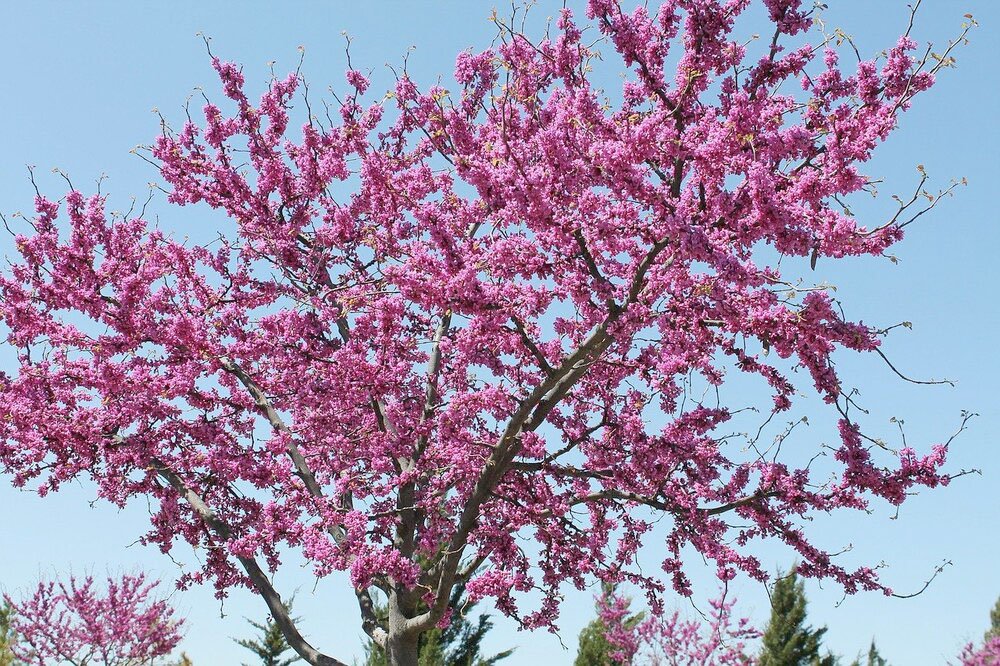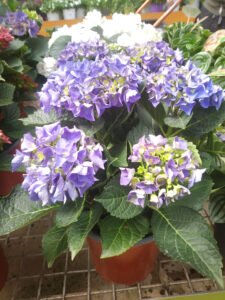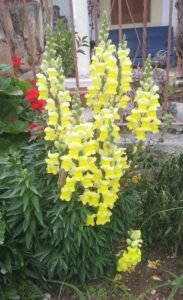By Patricia Jordan
The weather certainly keep you guessing in Cyprus, but at least April is here and although there may be some April showers, which are all to the good, they will shortly tail off. The rain refreshes the foliage, which may have become dusty recently. Springs are quite elusive in Cyprus and in the recent past few years we have had severe heat waves during April, which not only burned the new foliage but the tiny new fruits. As the lovely cercis blossom is gradually being hidden under its emerging bright green leaves, bauhinia trees are bursting into bloom on the city streets, showering their attractive blossoms over passers-by. These two wonderful trees are perhaps too large for the normal domestic garden but come into their own given space to grow. Viburnum tinus doesn’t disappoint being from this end of the Mediterranean and is full of pretty pink flowers, whilst the perfume from the flowers on the bay tree and Mediterranean hawthorn pervade the garden on warm days. Here bay is known as ‘Daphne’. Wisteria, which flowers before the leaves appear, is in full bloom adding to the many lovely perfumes roundabout and the bees are having a feeding frenzy as they flit from flower to flower!
I am always asked at this time of year why some daffodils do not produce any flowers. If the bulbs were newly bought and planted last autumn they should have flowered. If they didn’t, it is probably not a fault of yours as they may have been lifted too early before being packaged and sent from Holland. There are several reasons why bulbs don’t produce flowers. If they have been in the garden for a while, they might have become congested and need to be dug up and replanted deeper – around two or three times the height of the bulb. Removing the dead head as the flower dies and leaving the leaves to die down naturally should guarantee flowers for next season. Feed the bulbs now with a general fertiliser (all the same number) or it you can’t get that, a tomato fertiliser will do. Other bulbs like hyacinths may appear and flower for a couple of years or so, but the flower stems will become smaller and the lovely flowers greatly reduced. My paperwhites seem to defy all these rules without too much attention and were wonderful again this year and are now hopefully producing the flowers for next season as the foliage dies down.
Things to do in the garden this month
As the weather starts to warm up ants can become troublesome as they look to make new homes. Don’t let them get into flower pots or they will make nests there, completely killing off the plants. Either raise the pot off the ground on little Chinese ‘feet’, put the pot on a paving slab or if you are re-potting, put a piece of nylon tights or something similar over the drainage hole to stop them from entering the pot.
Snails and slugs have been having a field day this winter with all the rain, so check under the rims of pots that might have been lying around and turn over plant trays where you may find snails firmly attached to the undersides. Do get rid of them or they will play havoc with your spring bedding and salad crops. Sparrows are also attracted to fresh soft foliage, lettuce in particular and may peck them to pieces! Sweet corn plugs can be planted from now on but remember to grow them in squares if you can, as they are wind pollinated and on a breezy day you will see the pollen being blown off the tassels onto the flowers below. They do need space and their eventual height might put off people with small gardens, but the taste of them, picked straight from the garden, is a great pleasure. Now that the weather is relatively warm, watch out for green fly and black fly on your plants. Broad beans usually suffer from the latter when grown in the UK, but here they mature much earlier and usually escape them. If you grow the silver leaved artemisia you may find swarms of them on the stems. Early roses may well be affected by greenfly. If you are not squeamish then you can rub them off with a latex-gloved hand or use a soapy water spray. Obstinate pests may need more chemical treatment, which I am always reluctant to use if there is an alternative, so try the other treatments first.
Plant up hanging baskets now or if you don’t have the facilities to do that, the garden centres have a wonderful choice. Remember that a hanging basket doubles in weight when it is watered, so ensure that the hook or rail it is hanging from is secure and not likely to bring the support down. One of the best hanging baskets I had in recent years was filled with scaevola, whose flowers appear in a fan shape. They can also be used in the garden, but their sprawling habit is best shown off hanging from on high! There are many other flower combinations that look good and can withstand our summer heat, although you may like to ring the changes as the season progresses. I still like ivy leaved pelargoniums – those that you see trailing down the front of Austrian and Swiss chalets! They are very sturdy plants and can withstand any amount of abuse! In my cold garden they are outside all year long and with some feeding and dead heading they always look attractive.
Roses greatly benefit from a regular feeding routine from now if they are to flower all summer long. Someone told me that chopped banana skins spread around the root area is good for them as bananas have lots of potassium. I tried this once but didn’t notice much difference I’m afraid. There are lots of fuchsia plants around this year and they have become very popular. It’s lovely to watch their dainty bell-like flowers dance in summer breezes. However they cannot cope with our hot summers, unless grown high up in the mountains. You would be lucky to keep hydrangeas going as well, as they take a rest in our high summer temperatures. However, a blue hydrangea that I bought last year looked absolutely dead until it suddenly came into life recently and sent up new shoots from the root area, so it has been fed and watered and is coming on. Hydrangeas, known as Hortense here, which bloom on old wood do not need pruning and are better off for it. If you leave them alone, they’ll bloom more profusely the next season. However it is okay to go ahead and gently thin or deadhead them. Deeply water 3 times a week to encourage root growth. Large hydrangeas require more water, but all varieties benefit from consistent moisture. Feeding is something that needs care as too much can cause burning of the leaves. You may be able to find a special hydrangea fertiliser, but a slow release fertiliser for trees and shrubs will suffice. Interestingly, acidic soil produces blue or lavender flowers, whilst alkaline soil with a pH above 7 will produce pinks and reds.
Plant of the month – Antirrhinum majus
This popular perennial plant has the common name of ‘Snapdragon’ and is a well known favourite in many cottage gardens and courtyards. Although these plants may last for a couple of seasons or so, they are best grown as annuals. Some antirrhinums can reach 1 metre in height in ideal situations, but they may need some support. The tall flower stems are ideal for cutting to bring indoors, but they are generally shorter than that and make ideal plants for the front of the border or planters. The flowers can have strong or pastel colours and some are even bi-coloured, which contrast well with the dark green elongated leaves.
The name derives from the Greek – anti – meaning like, whilst rhis means a nose or snout, which is where the name snapdragon came from – a dragon’s snout. If you examine the snap dragons closely and press on the two-lipped flower, it opens up just like a mouth. The bees love them and are easily able to access the flowers to find the nectar inside. The plants are hermaphrodite, which just means that they have male and female organs.
Although their native habitat was in the Mediterranean, in very hot summers such as ours, they may not last all season. They prefer to grow in light sandy well-drained soil in semi-shade. Scatter the seeds thinly over the ground and spread a light covering of soil over them. It might be necessary to thin them out as they grow. Rust and mildew can be a problem with this plant, which is why it is better to grow new plants every year from seed. They may also be attacked by aphids.









Click here to change your cookie preferences